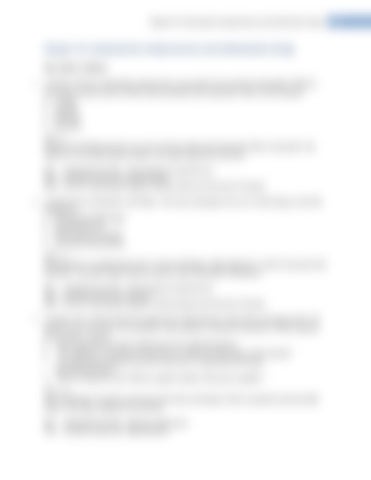Chapter 43: Antimalarial, Antiprotozoal, and Anthelmintic Drugs
Chapter 43: Antimalarial, Antiprotozoal, and Anthelmintic Drugs MULTIPLE CHOICE 1. A patient who has a helminthic infection has a prescription for pyrantel (Antiminth). Which is
one of the common adverse effects that the patient may experience while on this therapy? a. Vertigo b. Seizures c. Diarrhea d. Insomnia ANS: C
Diarrhea and abdominal pain are some of the possible gastrointestinal effects of pyrantel. See Table 43-11 for other adverse effects. The other options are incorrect. DIF: COGNITIVE LEVEL: Understanding (Comprehension) TOP: NURSING PROCESS: Implementation MSC: NCLEX: Physiological Integrity: Pharmacological and Parenteral Therapies 2. A patient has an infestation with flukes. The nurse anticipates the use of which drug to treat this
infestation? a. Praziquantel (Biltricide) b. Pyrantel (Pin-X) c. Metronidazole (Flagyl) d. Ivermectin (Stromectol) ANS: A
Praziquantel is an anthelmintic that is used to kill flukes. Metronidazole is used to treat protozoal infections. The other drugs listed are used for other helminthic infestations. DIF: COGNITIVE LEVEL: Understanding (Comprehension) TOP: NURSING PROCESS: Planning MSC: NCLEX: Physiological Integrity: Pharmacological and Parenteral Therapies 3. A patient who is being treated for malaria has started therapy with quinine and tetracycline. He
asks the nurse why he is on an antibiotic when malaria is caused by a parasite. Which response by the nurse is correct? a. “The tetracycline prevents reinfection by the malarial parasite.” b. “The antibiotic is combined with quinine to reduce the side effects of the quinine.” c. “An antibacterial drug prevents the occurrence of superinfection during antimalarial therapy.” d. “The two drugs are more effective against malaria when given together.” ANS: D
The combination of quinine and tetracycline takes advantage of their synergistic protozoacidal effects. The other responses are incorrect. DIF: COGNITIVE LEVEL: Applying (Application) TOP: NURSING PROCESS: Implementation
231
